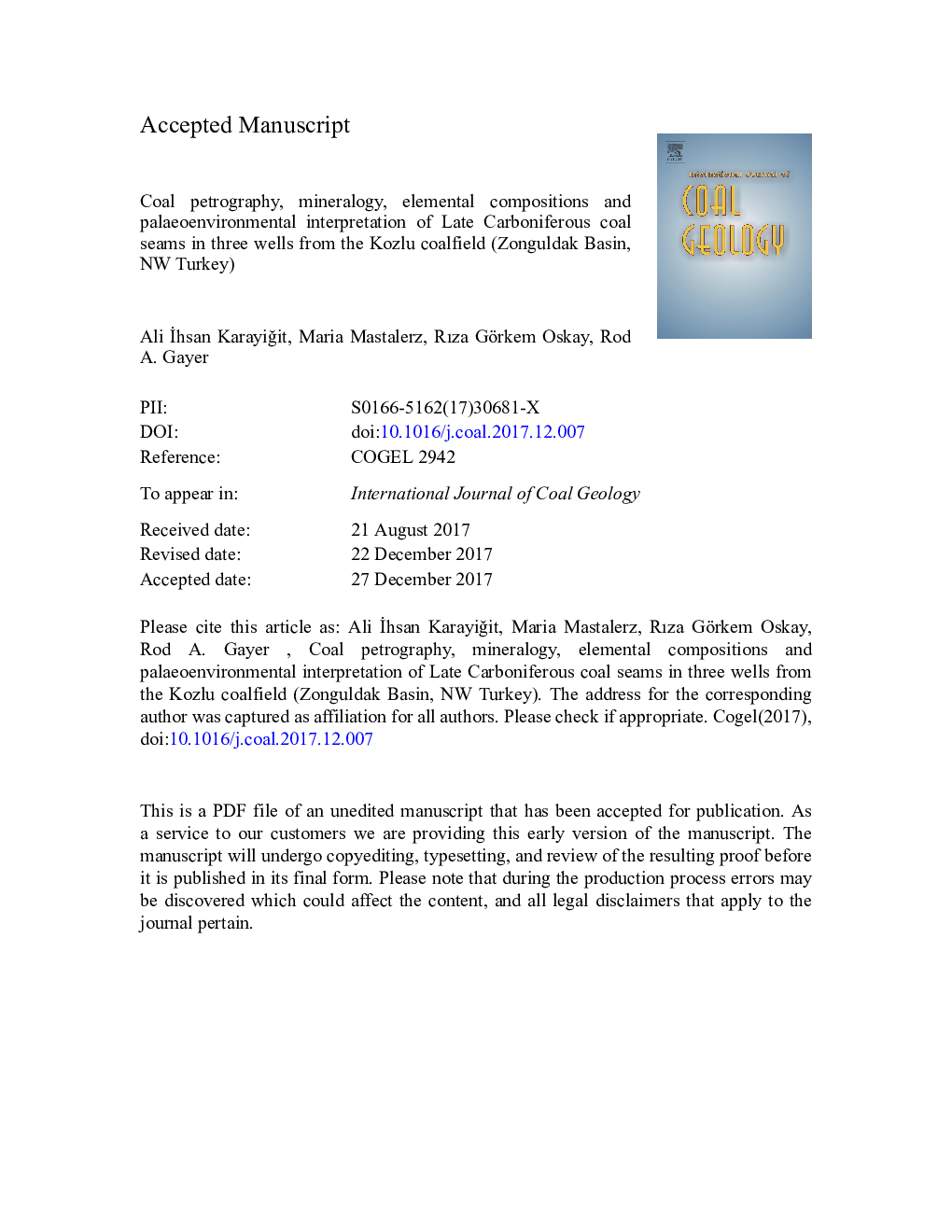| کد مقاله | کد نشریه | سال انتشار | مقاله انگلیسی | نسخه تمام متن |
|---|---|---|---|---|
| 8123557 | 1522516 | 2018 | 52 صفحه PDF | دانلود رایگان |
عنوان انگلیسی مقاله ISI
Coal petrography, mineralogy, elemental compositions and palaeoenvironmental interpretation of Late Carboniferous coal seams in three wells from the Kozlu coalfield (Zonguldak Basin, NW Turkey)
ترجمه فارسی عنوان
پتروگرافی زغال سنگ، کانی شناسی، ترکیبات عنصری و تفسیر پلاسمای محیط زیست دریای کربن بعد در سه چاه از زیرزمینی کوزلو (حوضه زونگولدک، شمال غربی ترکیه)
دانلود مقاله + سفارش ترجمه
دانلود مقاله ISI انگلیسی
رایگان برای ایرانیان
کلمات کلیدی
موضوعات مرتبط
مهندسی و علوم پایه
علوم زمین و سیارات
زمین شناسی اقتصادی
چکیده انگلیسی
A number of coal seams of Late Carboniferous age in the coal-bearing Karadon, Kozlu, and AlacaaÄzı formations have been mined in several deep underground mines in the Zonguldak Basin (NW Turkey). For this study, a total of 154 coal core samples were collected from three research wells that were drilled in the tectonically complex settings of the Kozlu coalfield. All the coal samples were studied by means of coal petrography, mineralogy, and geochemistry. Special attention was given to the compositions and origins of fracture/cleat-filling minerals that were identified by SEM-EDX on polished blocks. The coal seams investigated are of bituminous rank. They are characterized by low total sulphur contents (â¤Â 1.0%, on dry basis) and high gross calorific values (22.5-40.2 MJ/kg, on dry, ash-free basis), whereas ash yields and volatile matter contents are variable. X-ray powder diffraction data indicate that the mineralogical compositions of the studied coal seams are rather similar, and clay minerals, along with quartz and carbonate minerals, were identified in almost all seams. The statistical evaluations and SEM data show that some elements such as Mg, Ti, Zr, Nb, and Th are generally affiliated with silicate minerals, whereas elements like Cu, Zn, Mo, and Pb are mainly associated with sulphide minerals. The silicate minerals are generally detrital, and the majority of carbonate minerals are of epigenetic origin. The epigenetic carbonate and sulphide minerals suggest that circulated solutions within coal seams were mainly derived from Ca2 +-rich solutions leached from overlying formations such as Cretaceous aged Zonguldak formations and from hydrothermal solutions that likely were derived from andesitic dykes within the basin. The regional tectonic activities during coalification seem to have deformed coal-bearing formations and, therefore, intra-basinal solutions could have penetrated into the studied coal seams. The epigenetic mineralisation also resulted in elemental enrichments and elevated ash yields, total sulphur, and volatile matter contents in some coal seams. Thus, deformation during coalification controlled some coal quality parameters in the studied wells. The coal facies diagrams suggest that palaeomires mostly accumulated under limno-telmatic conditions, whereas a telmatic environment was more common in palaeomires of the Kozlu Formation. Coal petrography suggests that peat-forming vegetation and water tables in palaeomires were changeable during the Late Carboniferous.
ناشر
Database: Elsevier - ScienceDirect (ساینس دایرکت)
Journal: International Journal of Coal Geology - Volume 187, 15 February 2018, Pages 54-70
Journal: International Journal of Coal Geology - Volume 187, 15 February 2018, Pages 54-70
نویسندگان
Ali Ä°hsan KarayiÄit, Maria Mastalerz, Rıza Görkem Oskay, Rod A. Gayer,
